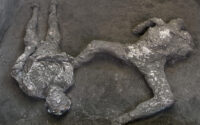 New plaster casts have been made of two victims of the eruption of Vesuvius in a villa on the outskirts of Pompeii. The skeletal remains of two adult men were found in a side room of the cryptoporticus at the suburban villa at Civita Giuliana about half a mile northwest of Pompeii’s city walls. This is the same villa where the remains of a purebred horse dressed with a bronze-plated saddle and tack, were found in the stables in 2018. A graffito discovered earlier this year suggests the estate may have belonged to a member of the wealthy and influential Mummius family.
New plaster casts have been made of two victims of the eruption of Vesuvius in a villa on the outskirts of Pompeii. The skeletal remains of two adult men were found in a side room of the cryptoporticus at the suburban villa at Civita Giuliana about half a mile northwest of Pompeii’s city walls. This is the same villa where the remains of a purebred horse dressed with a bronze-plated saddle and tack, were found in the stables in 2018. A graffito discovered earlier this year suggests the estate may have belonged to a member of the wealthy and influential Mummius family.
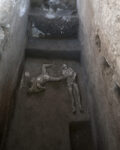 The room where the two bodies were found is in the northwest residence where the family and guests lived. It’s next to the cryptoporticus below the terrace peristyle garden overlooking the Bay of Naples. A vaulted opening led from the cryptoporticus to a rectangular room that allowed access to the upper floor. The room was seven feet wide and of undetermined length. It had a wooden floor and was destroyed when the first stories of the house collapsed when it was
The room where the two bodies were found is in the northwest residence where the family and guests lived. It’s next to the cryptoporticus below the terrace peristyle garden overlooking the Bay of Naples. A vaulted opening led from the cryptoporticus to a rectangular room that allowed access to the upper floor. The room was seven feet wide and of undetermined length. It had a wooden floor and was destroyed when the first stories of the house collapsed when it was 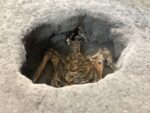 slammed by the pyroclastic flow. Archaeologists first found the tell-tale hollows in the layers of hardened ash that were left behind after the soft tissues of the bodied decayed. Digging down through a small hole to preserve as much of the void as possible, archaeologists found the bones. Most of them were removed for analysis. Plaster was then poured into the voids to capture the shape of the bodies.
slammed by the pyroclastic flow. Archaeologists first found the tell-tale hollows in the layers of hardened ash that were left behind after the soft tissues of the bodied decayed. Digging down through a small hole to preserve as much of the void as possible, archaeologists found the bones. Most of them were removed for analysis. Plaster was then poured into the voids to capture the shape of the bodies.
They were both in supine position. One was a young man between 18 and 25. He was approximately 5’1″ tall and evidence of compression of his 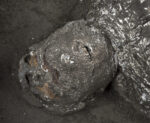 vertebrae, unusual in someone so young, indicates he had carried out manual labour for a long time. The imprint of his clothing was left in the ash hollow and therefore on the cast. He was wearing a short tunic of heavy fabric, likely wool. The tunic and bone damage suggests he may have been a slave. The other victim was found with his head turned, cheek in the hardened ash, his arms folded, hands on his chest, legs spread wide apart. He was older than the first victim, between 30 and 40, and an inch taller. He was more elaborately attired in a tunic topped with a woollen mantle.
vertebrae, unusual in someone so young, indicates he had carried out manual labour for a long time. The imprint of his clothing was left in the ash hollow and therefore on the cast. He was wearing a short tunic of heavy fabric, likely wool. The tunic and bone damage suggests he may have been a slave. The other victim was found with his head turned, cheek in the hardened ash, his arms folded, hands on his chest, legs spread wide apart. He was older than the first victim, between 30 and 40, and an inch taller. He was more elaborately attired in a tunic topped with a woollen mantle.
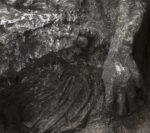 Both died in the second pyroclastic flow. They and the other Pompeiians had survived the pumice rain that fell for 19 hours an the first pyroclastic flow that struck the town when the eruptive column collapsed. Vesuvius then tricked them by quieting down for about half an hour, just long enough to encourage the survivors to leave their hiding places and attempt to flee with their lives. The second pyroclastic flow hit with sudden fury, faster and far more powerful than the first, blowing through vertical walls, pancaking the tops of buildings into the bottoms and killing the people who had hoped to escape their fate. The flow appears to have flooded the room in the Civita Giuliana villa through multiple points of entry, engulfing the men in hot ash that would harden into their tomb. Their entire bodies were encased in a gray ash layer 6.5 feet deep created by the second flow.
Both died in the second pyroclastic flow. They and the other Pompeiians had survived the pumice rain that fell for 19 hours an the first pyroclastic flow that struck the town when the eruptive column collapsed. Vesuvius then tricked them by quieting down for about half an hour, just long enough to encourage the survivors to leave their hiding places and attempt to flee with their lives. The second pyroclastic flow hit with sudden fury, faster and far more powerful than the first, blowing through vertical walls, pancaking the tops of buildings into the bottoms and killing the people who had hoped to escape their fate. The flow appears to have flooded the room in the Civita Giuliana villa through multiple points of entry, engulfing the men in hot ash that would harden into their tomb. Their entire bodies were encased in a gray ash layer 6.5 feet deep created by the second flow.
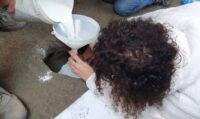 Other voids were discovered in this room three or so feet from the victims. The hollows were manually examined and plaster poured into them revealing items that may have been lost during the attempted escape, mainly heaps of heavy, draped cloth. The wool clothes they were wearing and carrying are additional evidence that the eruption took place October 24-25, not the traditional August date that may be the result of a medieval translation error.
Other voids were discovered in this room three or so feet from the victims. The hollows were manually examined and plaster poured into them revealing items that may have been lost during the attempted escape, mainly heaps of heavy, draped cloth. The wool clothes they were wearing and carrying are additional evidence that the eruption took place October 24-25, not the traditional August date that may be the result of a medieval translation error.
This video shows the process of opening the voids, pouring the plaster and excavating the casts.
Working on behalf of a US hard- and software company, I once received a complaint from a customer, who –as he put it– had “semi naked men in togas running around on the computer screen” 😮
O tempora, o mores!!!– It turned out, the CD-ROM production facility in the ‘Low Countries’ had distributed a BBC documentary “The last day of Pompeii” in the SW packs, and had to be stopped.
:hattip:
—–
From the documentary, I very well remember the catchphrase: “Fortunatus, Alexander, …Is anybody in here?!?”
If the second person was found “face-down in the hardened ash,” then he could not have been in a supine position as stated.
True, that was poorly written. His head was turned cheek-down. I’ll edit the post. :thanks:
Ah, so the slave expires without fuss, while the rich old man has to put on a show, even though there is no one there to see it.